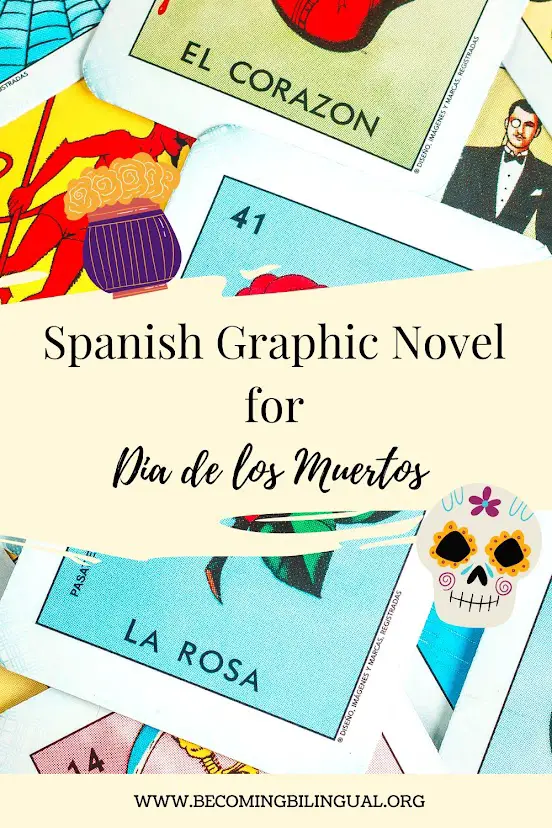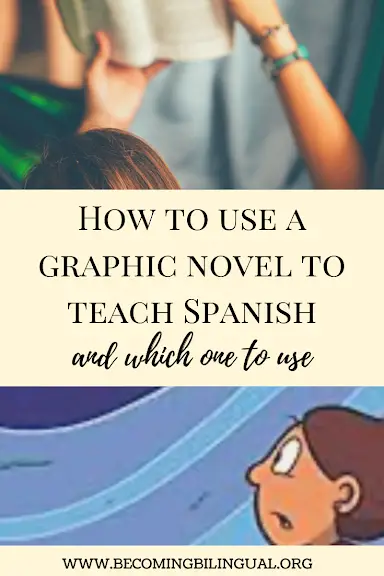Easy Language Learning With A Graphic Novel

Last Updated on January 28, 2023 by Reina Victoria
It’s almost Dia de los Muertos! For the month of October, my daughter and I usually read a book a day that has to do with the popular Mexican holiday – Dia de los Muertos (and yes, we have that many books!)
While this has been one of my favorite graphic novels for many years, it’s my first years reading it with my daughter, who just turned 7.
Reading graphic novels in Spanish has been one way to boost my daughter’s interest and engagement in reading in Spanish. It’s also a fun way to read together, though most people don’t traditionally think of “reading aloud” a graphic novel to their child.
Today’s post is about a graphic novel that I highly recommend, “Fantasmas”. I’ll share some tips for reading graphic novels out loud to your child, why I love “Fantasmas” so much, and how you can use it to support learning about Dia de los Muertos.
This post contains affiliate links. If you click an affiliate link and make a purchase, I earn a small commission which supports this blog at no additional cost to you. Please see the Privacy Policy for details. Thank you for helping to keep my blog running – I appreciate the support!
Table of Contents
How to read a graphic novel aloud to your child
When most people think about reading aloud a book to their child they think about reading a picture book or reading from a chapter book. Not many families consider reading graphic novels out loud together since it’s sort of a newer book format.
I’ve found that there’s an art to reading a graphic novel to your child and it’s not quite the same as a traditional read aloud.
It’s imperative that you and your child can both see the pages well and it’s also important that you both be able to reach and touch them as well.
When reading a graphic novel to a child for the first time or to a language learner, it can be helpful to point to the frame that you’re reading so that the child can follow the order of the frames across and down the page. Most children inherently understand that reading happens from left to right, but when you’re working with a graphic novel that has multiple frames on the page, it can be hard for kids to follow the correct order.
Because your eyes can take in information from the illustrations faster than it can from hearing the words read aloud, it’s often easy to blow through graphic novels without getting the full enjoyment from the words of the story.
Since you’re reading this to boost your Spanish skills, it’s important to linger on each page and talk about the images that you see.
When I read graphic novels with my daughter we often study the character’s faces and think about how they’re feeling or look for clues in the setting to help us figure out what might happen next.
This lingering also helps to build more language around the text and increases her engagement in the story.
For graphic novels for beginning readers, check out this article. All of these are books that I have read to my daughter or that she has read on her own:
Reading To Improve: Beginner Graphic Novels

“Fantasmas” by Raina Telgemeier
There are many joys to reading a graphic novel and they’re quite popular among tweens today.
This book is a good resource for you as a parent learning Spanish, as a book to read aloud with your child who is also learning Spanish, or as a book for your older child to read if they can already read in Spanish.
“Fantasmas” is one of the many graphic novels that Raina Telgemeier has written.
As in several of her other stories, Telgemeier writes a middle school age girl who also has a sibling and explores the dynamics of her social life as well as her family life.
This story is about a girl named Cat whose family moves to a new town to reap the climate benefits of living by the ocean.
Cat’s younger sister Maya has cystic fibrosis and the family is hoping the new climate will help her to breathe better.
The title “Fantasmas” or ghosts, refers to the actual ghosts that haunt their new town and also Cat’s fear that her sister may die from the cystic fibrosis and become a ghost.
Here’s what I love about it
Images to Support Comprehension
Reading this book, or any graphic novel, to support Spanish language is ideal because of the high quality images. Reading a traditional chapter book can be challenging if you run into vocabulary that is unfamiliar- you risk loosing the meaning of the page.
A graphic novel, however, leaves nothing to chance, since the whole story can be understood from the images and the words can be there to support your language acquisition.
Dialog
As with most graphic novels, the story is driven by action taking place in the images and the dialog of the characters. Reading constant dialog is an important part of learning Spanish as it gives the reader access to common phrases that they can immediately use.
Since most of the dialog is between two people, the phrases often have common “commands” and use the “tú” form of the verb. Hearing the correct grammar for informal speech can give readers a bank of phrases that they can also use in their day-to-day Spanish speech.
Cultural Aspect
In the story, Cat’s family is Hispanic and while they don’t identify strongly with their heritage, they meet other families in their new town who do. Cat learns more about traditional foods, Día de los Muertos and having a strong community bond. Just as Cat is getting an introduction to different aspects of Hispanic culture, so can you and your family.
Since I’m not of Hispanic heritage, this is one of the many books that we have that helps to support our understanding of different traditions. Just like Cat in the story is learning about Dia de los Muertos, we learned quite a bit, too.
If you’re looking for literature for older kids that support this theme, this book is definitely worth reading!

If you’re looking for a great Spanish book to start reading for your own language journey or for your child, this graphic novel is a great choice. It’s beautiful layout and tie to Hispanic culture make it a good choice for Spanish learners!
Here are some more Spanish graphic novels by Raina Telgemeier that we own and enjoy!
For more great Spanish graphic novels, check out these posts!
The Best Graphic Novels For Kids- in Spanish
Do you have any other Spanish books that you recommend? Let me know about them in the comments!
Happy Learning!
Don’t forget to subscribe here so you can get my latest posts and resources delivered right to your inbox!




6 thoughts on “Easy Language Learning With A Graphic Novel”